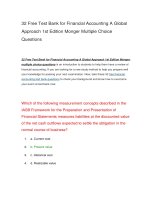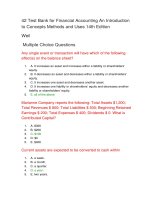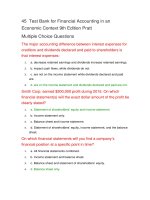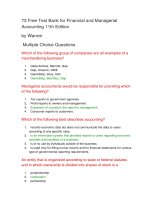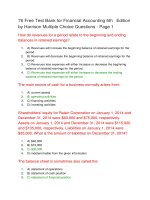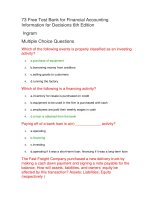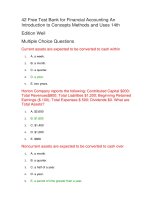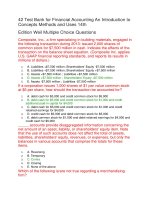42 free test bank for financial accounting an introduction to concepts methods and uses 14th
Bạn đang xem bản rút gọn của tài liệu. Xem và tải ngay bản đầy đủ của tài liệu tại đây (74.33 KB, 15 trang )
42 Free Test Bank for Financial Accounting An
Introduction to Concepts Methods and Uses 14th
Edition Weil
Multiple Choice Questions
Current assets are expected to be converted to cash within
1.
A. a week.
2.
B. a month.
3.
C. a quarter.
4.
D. a year.
5.
E. two years.
Horton Company reports the following: Contributed Capital $200;
Total Revenues$800; Total Liabilities $1,200; Beginning Retained
Earnings ($ 100); Total Expenses $ 500; Dividends $0. What are
Total Assets?
1.
A. $2,600
2.
B. $1,600
3.
C. $1,400
4.
D. $1,000
5.
E. $800
Noncurrent assets are expected to be converted to cash over
1.
A. a month.
2.
B. a quarter.
3.
C. a half of a year.
4.
D. a year.
5.
E. a period of time greater than a year.
For manufacturing firms, the balance sheet reports the costs of
incomplete items as
1.
A. Raw Materials Inventory.
2.
B. Work-in-Process Inventory.
3.
C. Finished Goods Inventory.
4.
D. Cost of goods ready for sale.
5.
E. none of the above
Which of the following is/are true regarding the T-account?
1.
A. Actual practice does not use this form of the account, except perhaps for
memoranda or preliminary analyses
2.
B. looks like the letter T, with a horizontal line bisected by a vertical line.
3.
C. satisfies the requirement of an account and is easy to use.
4.
D. all of the above
5.
E. none of the above
T-accounts are frequently used in textbooks, demonstration
problems, and examinations to accumulate information about the
effects of business transactions on individual balance sheet
accounts and to prepare the balance sheet. Alternatively, to
accomplish the same objectives, some instructors and students
might prefer to use
1.
A. a computer spreadsheet program.
2.
B. P-accounts, only.
3.
C. a single-entry bookkeeping system.
4.
D. P&L-accounts.
5.
E. L-accounts, only.
Conrad Company reports the following: Total Assets $800;
Contributed Capital $300; Total Revenues $600; Beginning
Retained Earnings $200; Total Expenses $700; Dividends $100.
What are Total liabilities?
1.
A. $600
2.
B. $500
3.
C. $400
4.
D. $300
5.
E. $200
Retained Earnings measures the cumulative excess of _____ for
the life of a firm
1.
A. dividends over net income
2.
B. net income over dividends
3.
C. assets over liabilities
4.
D. liabilities over shareholders’ equity
5.
E. shareholders’ equity over liabilities
What does the word “marketable” imply as far as “marketable
securities”?
1.
A. It implies that the securities should be classified as a temporary account.
2.
B. It implies that a firm owes money on the securities.
3.
C. It implies that the securities are considered to be goodwill.
4.
D. It implies that the firm can readily buy and sell the securities on an
exchange.
5.
E. It implies that the firm has signed a formal written contract called an
indenture.
Prepaid assets are valued on the balance sheet at
1.
A. cost paid to acquire the asset.
2.
B. acquisition cost less accumulated depreciation.
3.
C. cost less expired portion.
4.
D. replacement cost.
5.
E. present value of future cash flows.
Which of the following is/are true regarding T-accounts?
1.
A. for each transaction, the amount entered on the left side of (or debited
to) the accounts for each transaction equals the amount entered on the right
side of (or credited to) the accounts.
2.
B. recording equal amounts of debits and credits for each transaction
ensures that the balance sheet equation will always balance.
3.
C. one side of the space formed by the vertical line records increases in the
item and the other side records decreases.
4.
D. all of the above
5.
E. none of the above
Temporary accounts are for recording
1.
A. revenues and expenses.
2.
B. assets.
3.
C. liabilities.
4.
D. shareholders’ equity.
5.
E. assets, liabilities, and shareholders’ equity.
Before preparing the balance sheet and income statement, an
accountant would use what accounting record to first record the
firm's transactions?
1.
A. the trial balance
2.
B. the adjusting entry
3.
C. the general ledger
4.
D. the subsidiary ledger
5.
E. the journal
Under U.S. GAAP, assets and liabilities in the balance sheet
appear in order of
1.
A. decreasing closeness-to-cash.
2.
B. increasing closeness-to-cash.
3.
C. alphabetical order.
4.
D. numerical order.
5.
E. all of the above.
A T-account is a device or convention for organizing and
accumulating the accounting entries of transactions that affect an
individual account. Which of the following is/are true?
1.
A. Increases in assets appear on the left side, and decreases in assets
appear on the right side of T-accounts.
2.
B. Increases in liabilities appear on the right side, and decreases in
liabilities appear on the left side of T-accounts.
3.
C. Increases in shareholders’ equity appear on the right side, and
decreases in shareholders’ equity appear on the left side of T-accounts
4.
D. all of the above are true
5.
E. none of the above are true
If a corporation issues 1,000 shares of $1 par value common
stock at $5 per share, how should the transaction be accounted
for?
1.
A. debit cash for $5,000 and credit common stock for $5,000
2.
B. debit cash for $5,000 and credit common stock for $1,000 and credit
additional paid-in capital for $4,000
3.
C. debit cash for $5,000 and credit common stock for $1,000 and credit
retained earnings for $4,000
4.
D. credit cash for $5,000 and debit common stock for $5,000
5.
E. debit common stock for $1,000 and debit retained earnings for $4,000
and credit cash for $5,000
To maintain balance sheet equality, it is necessary to report every
event and transaction in a dual manner. If a transaction results in
an increase in a Liability account, then which of the following must
occur, to maintain the balance sheet equation?
1.
A. decrease another liability.
2.
B. decrease shareholders’ equity.
3.
C. increase an asset.
4.
D. all of the above will maintain the balance sheet equation
5.
E. none of the above
Which of the following is/are not true regarding a merchandising
firm?
1.
2.
A. Inventory appears on the merchandiser’s balance sheet initially as an
asset.
B. Inventory for a merchandiser is measured at acquisition cost.
3.
C. When a sale takes place, the merchandising firm recognizes the cost of
the inventory as an expense (cost of goods sold) on the income statement.
4.
D. When a sale takes place, the merchandising firm recognizes the
inventory reduction on the statement of cash flows.
5.
E. All of the above are false regarding a merchandising firm.
C-Swiss, a Swedish firm specializing in communication networks,
reported a balance in Inventories of SEK21,500 million at the
beginning of 2013 and SEK22,500 million at the end of 2013.
During 2013, C-Swiss reported SEK114,100 million in Cost of
Sales. How much was C-Swisss’ inventory purchases during
2013? [Assume that all of C-Swisss’ inventory purchases are
made on account and C-Swiss applies IFRS, as well as reports its
results in millions of Swedish kronor (SEK).]
1.
A. SEK115,300 million
2.
B. SEK115,200 million
3.
C. SEK115,100 million
4.
D. SEK113,100 million
5.
E. none of the above
_____ accounts provide disaggregated information concerning
the net amount of an asset, liability, or shareholders' equity item.
Note that the use of such accounts does not affect the total of
assets, liabilities, shareholders' equity, revenues, or expenses,
but only the balances in various accounts that comprise the totals
for these items.
1.
A. Reversing
2.
B. Temporary
3.
C. Contra
4.
D. Closing
5.
E. None of the above
The accounting system uses a device called an account. An
account
1.
2.
A. is created each time a transaction takes place.
B. accumulates the increases and decreases that occur during the period
for a single item.
3.
C. is created only for income statement items.
4.
D. is created only for balance sheet items.
5.
E. is created only for statement of cash flows items.
The equation that describes the relationship between the balance
sheet and the income statement through the Retained Earnings
account is as follows:
1.
A. Retained Earnings (beginning) - Net Income = Retained Earnings
(ending)
2.
B. Retained Earnings (beginning) + Net Income + Dividends = Retained
Earnings (ending)
3.
C. Retained Earnings (beginning) - Net Income - Dividends = Retained
Earnings (ending)
4.
D. Retained Earnings (beginning) - Net Income + Dividends = Retained
Earnings (ending)
5.
E. Retained Earnings (beginning) + Net Income - Dividends = Retained
Earnings (ending)
Energy Corporation, a U.S. diversified power management
company, reported a balance in Retained Earnings of $2,800
million at the beginning of 2013 and $3,300 million at the end of
2013. Based on Energy Corporation’s financial reports for fiscal
2013, it reported dividends declared and paid of $250 million for
2013. Compute the amount of net income for 2013. (Energy
Corporation applies U.S. GAAP, and reports its results in millions
of U.S. dollars.)
1.
A. -$250 million
2.
B. $250 million
3.
C. $550 million
4.
D. $750 million
5.
E. none of the above
Tokyo Motor Company (Tokyo), a Japanese car manufacturer,
reported Sales of Products of ¥22,670 billion for the year ended
March 31, 2014. The Cost of Products Sold was ¥18,356 billion.
Assume that Tokyo made all sales on credit. Select the correct
journal entries that Tokyo made during the fiscal year ended
March 31, 2014, related to these transactions. [Tokyo applies
U.S. GAAP, and reports its results in millions of yen (¥).]
1.
A. Accounts Receivable ¥22,670 billion; Inventories ¥22,670 billion; Cost of
Goods Sold ¥18,356 billion; Revenues ¥18,356 billion
2.
B. Accounts Receivable ¥18,356 billion; Inventories ¥18,356 billion; Cost of
Goods Sold ¥22,670 billion; Revenues ¥22,670 billion
3.
C. Accounts Receivable ¥18,356 billion; Revenues ¥18,356 billion; Cost of
Goods Sold ¥22,670 billion; Inventories ¥22,670 billion
4.
D. Accounts Receivable ¥22,670 billion; Revenues ¥22,670 billion; Cost of
Goods Sold ¥18,356 billion; Inventories ¥18,356 billion
5.
E. none of the above
Skyway Company, a U.S. airplane manufacturer, reported a
balance of $8,100 million in Inventory at the beginning of 2013
and $9,600 million at the end of 2013. Its income statement
reported Cost of Products Sold of $45,400 million for 2013.
Compute the cost of inventory either purchased or manufactured
during 2013. (Skyway Company applies U.S. GAAP, and reports
its results in millions of U.S. dollars.)
1.
A. $49,500 million
2.
B. $39,900 million
3.
C. $46,900 million
4.
D. $39,900 million
5.
E. none of the above
Current liabilities
1.
A. are obligations that a firm expects to pay or discharge during the normal
operating cycle of the firm, usually one year.
2.
B. include liabilities to merchandise suppliers, employees, and
governmental units.
3.
C. include notes and bonds payable to the extent that they will require the
use of current assets within the next year.
4.
D. include all of the above.
5.
E. None of the above answers is correct.
Assets are classified as current for reporting purposes when
1.
A. shares of common stock in a company's important supplier are acquired
to ensure continued availability of raw materials.
2.
B. shares of common stock in another company are acquired to diversify
operations.
3.
C. expenditures are made in developing new technologies or advertising
products.
4.
D. they are reasonably expected to be turned into cash or to be sold or
consumed during the normal operating cycle of the business.
5.
E. they are reasonably expected to be turned into cash or to be sold or
consumed within the next three years.
The first step in the accounting record-keeping process is:
1.
A. recording each transaction in a file or other record in the form of a
journal entry.
2.
B. posting the amounts from the journal entries to individual balance sheet
and income statement accounts in a general ledger.
3.
C. making adjusting journal entries to the accounts to correct errors and to
reflect the financial statement impacts of items that occur because of usage
or the passage of time.
4.
D. preparing the income statement for the period from amounts in the
income statement accounts.
5.
E. preparing the balance sheet from amounts in the balance sheet
accounts.
T-accounts
1.
A. summarize the effects of transactions on specific accounts.
2.
B. show all the accounts affected by a single event or transaction.
3.
C. provide a record of transactions.
4.
D. all of the above
5.
E. none of the above
Marianne Company reports the following: Total Assets $1,200;
Total Revenues $ 800; Total Liabilities $ 500; Beginning Retained
Earnings $ 200; Total Expenses $ 400; Dividends $ 0. What is
Contributed Capital?
1.
A. $300
2.
B. $200
3.
C. $100
4.
D. $0
5.
E. $400
What (other than a transactions spreadsheet ) serves the function
of accumulating information about the effect of business
transactions on each balance sheet and income statement
account?
1.
A. Journals
2.
B. P&L-accounts
3.
C. T-accounts
4.
D. Subsidiary Ledgers
5.
E. Library
Any single event or transaction will have which of the following
effect(s) on the balance sheet?
1.
A. It increases an asset and increases either a liability or shareholders’
equity.
2.
B. It decreases an asset and decreases either a liability or shareholders’
equity.
3.
4.
5.
C. It increases one asset and decreases another asset.
D. It increases one liability or shareholders’ equity and decreases another
liability or shareholders’ equity.
E. all of the above
Brice Foods Group, a European food retailer that operates
supermarkets in seven countries, engaged in the following
transaction during 2013: purchased and received inventory
costing €500 million on account from various suppliers. Indicate
the effects of the transaction on the balance sheet equation. Brice
Foods Group applies IFRS, and reports its results in millions of
euros.
1.
A. Assets + €500 million; Liabilities + €500 million
2.
B. Assets + €500 million; Shareholders’ Equity + €500 million
3.
C. Liabilities + €500 million; Shareholders’ Equity + €500 million
4.
D. Liabilities + €500 million; Shareholders’ Equity - €500 million
5.
E. Assets + €500 million; Shareholders’ Equity - €500 million
Composite, Inc., a firm specializing in building materials, engaged
in the following transaction during 2013: issued 2,000 shares of
common stock for $7,500 million in cash. Indicate the effects of
the transaction on the balance sheet equation. (Composite Inc.
applies U.S. GAAP financial reporting standards, and reports its
results in millions of dollars.)
1.
A. Liabilities +$7,500 million; Shareholders’ Equity -$7,500 million
2.
B. Liabilities +$7,500 million; Shareholders’ Equity +$7,500 million
3.
C. Assets +$7,500 million ; Liabilities +$7,500 million
4.
D. Assets +$7,500 million ; Shareholders’ Equity +$7,500 million
5.
E. Assets -$7,500 million ; Liabilities -$7,500 million
A detailed system of accounts allows the preparer of financial
statements to decompose, or __________, each transaction to
convey information about the effects of the transaction.
1.
A. mixup
2.
B. disaggregate
3.
C. aggregate
4.
D. share
5.
E. combine
Which of the following is false regarding a merchandising firm?
1.
A. A merchandising firm purchases inventory for resale.
2.
B. A merchandising firm does not change the physical form of the inventory.
3.
C. A merchandising firm performs no incremental work on the inventory.
4.
5.
D. A merchandising firm adds nothing to the acquisition cost of the
inventory after it is purchased.
E. None of the above are false regarding a merchandising firm.
Which of the following is/are true regarding the T-account?
1.
A. the name or title of the account appears on the horizontal line.
2.
B. dates and other information can appear in T-accounts.
3.
C. one side of the space formed by the vertical line records increases in the
item and the other side records decreases.
4.
D. all of the above
5.
E. none of the above
On April 1, Year 1, Colonial Bookstore bought an insurance policy
costing $24,000 that would insure the retail building for two years
against fire loss. What asset account and what amount are
recorded on the balance sheet at December 31, Year 1?
1.
A. Prepaid Insurance, $15,000
2.
B. Insurance Expense, $15,000
3.
C. Prepaid Insurance, $9,000
4.
D. Insurance Expense, $9,000
5.
E. Prepaid Insurance, $12,000
To maintain the balance sheet equality, it is necessary to report
every event and transaction in a dual manner. If a transaction
results in an increase in the left hand side of the balance sheet,
dual transactions recording requires that which of the following
must occur, to maintain the balance sheet equation?
1.
A. decrease another asset
2.
B. increase a liability
3.
C. increase shareholders equity
4.
D. all of the above will maintain the balance sheet equation
5.
E. none of the above
Accounting is governed by the balance sheet equation, which
shows the equality of
1.
A. assets with liabilities plus shareholders’ equity.
2.
B. assets plus liabilities with shareholders’ equity.
3.
C. assets plus shareholders’ equity with liabilities.
4.
D. assets with liabilities minus shareholders’ equity.
5.
E. assets with shareholders’ equity minus liabilities.
Journal entries
1.
A. show all the accounts affected by a single event or transaction.
2.
B. provide a record of transactions.
3.
C. have the characteristics presented in choices a and b.
4.
D. summarize the effects of transactions on specific accounts.
5.
E. none of the above
Under IFRS, assets and liabilities in the statement of financial
position appear in order of
1.
A. decreasing closeness-to-cash.
2.
B. increasing closeness-to-cash.
3.
C. alphabetical order.
4.
D. numerical order.
5.
E. all of the above.
